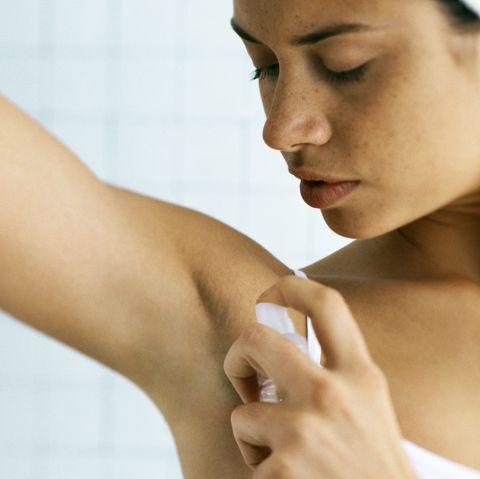Remedies for your Armpits From Sweating Excessively
You probably know the feeling of sweat trickling down from your armpits on a super hot day, or when you’re all jittery before a big meeting or presentation. And that’s normal! But for some, a hot day (or any day for that matter) doesn’t produce just a small amount of sweat—it creates a torrential downpour in the pit area. “Sweating Excessively”
A quick health lesson: Sweating is your body’s way of keeping your temperature in check and keeping you cool. When you’re getting overheated—say, because you’ve been exercising or because it’s a warm day—your body sweats and then the sweat evaporates off of your skin, which helps to regulate your overall body temperature,

Everybody sweats different amounts, too. Some people may sweat less than a liter a day, while others may sweat several liters. This all depends on your body, your genetics, the climate you live in, and your physical activity levels. So if you notice you feel pretty damp under your armpits and your coworker seems totally comfortable temperature-wise beside you, don’t assume you have a problem—everybody sweats differently and more or less in different parts of the body.
But if you feel like your armpits are *much* wetter than they should be (and not just when it’s a scorcher out there or you’re standing body to body on public transportation) and it’s interfering with your life, you could be dealing with what’s known as hyperhidrosis.
What is hyperhidrosis?
An estimated 3 percent of people in the U.S. deal with excessive sweating, which is known as hyperhidrosis,. Someone who has hyperhidrosis sweats more than is physically necessary for the body and even when they don’t need a cool-down. It’s not totally clear what causes hyperhidrosis in every case, but it could be genetic for some people, or related to another underlying health issue.
There are two types of hyperhidrosis—primary and secondary:
- Primary hyperhidrosis:This means that there’s no underlying cause to your sweat, according to the AAD. People who have primary hyperhidrosis typically start to notice excessive sweat as a child or a teenager.
- Secondary hyperhidrosis: This is when your sweating is related to some other underlying health issue—it’s not just a thing your body does. For example, you’re taking a medication that triggered excessive sweating, you have diabetes, you’re going through menopause, or you have an overactive thyroid.
Most of the time, hyperhidrosis only happens in one or two areas of the body. So, you might see a lot of sweat under your armpits and on your forehead, but nowhere else. “Sweating Excessively”
While it sounds pretty uncomfortable, excessive sweating likely isn’t a serious risk to your health. That being said, it can be a pain and a little embarrassing. Going on first dates or job interviews could lead to some pretty embarrassing situations. Maybe you’d stop scheduling dates altogether or, at least, you’d spend a ton of time thinking up a sweat strategy before you go out, and then worry about your sweat the whole night. That sounds pretty miserable, right?
Hopefully, that kind of debilitating sweating would lead you to a doctor’s office. But it often doesn’t, the AAD notes. Lots of people with excessive sweating likely never reach out to a doctor for help, either because they’re too embarrassed to talk about their sweat problem or because they assume it’s a burden they have to bear. “Sweating Excessively”
But that’s a mistake, because a doctor could help you figure out how to stop the sweat—and whether your sweat is excessive in the first place.
Not sure if your level of armpit sweat would quality as hyperhidrosis? Here’s how to tell.
“Normal” is hard to quantify. Sweat is one of those things that can easily freak us out, so it’s possible that you *think* you sweat way too much, but you actually have a totally normal amount of sweat.
So imagine this scenario: It’s a nice day—80 degrees, sunny—and you’re sitting in the park with friends. You’re not playing frisbee or running around or exerting yourself in any way. You’re just sitting. It’d be normal to sweat a little bit, sure, but you shouldn’t feel sweat dripping from your armpits, down your back, or anywhere else. “If sweat is dripping down the sides of [your body], or frequently soaking through your shirts at rest, that would be considered excessive sweating,”
So if a day like that does make you drip sweat, you might have hyperhidrosis. Even if you’re *still* not sure, it’s worth making an appointment with a dermatologist. The first thing your dermatologist will do is determine if you have primary hyperhidrosis or secondary hyperhidrosis. “Sweating Excessively”
Hyperhidrosis treatment depends on whether you’re dealing with the primary or secondary type.
Your doctor will ask about your sweating history to try to determine which category you fall under. And, if it’s secondary hyperhidrosis, addressing the root cause (i.e. diagnosing and treating a thyroid issue or getting through menopause) should help dial down the amount you sweat.
If your hyperhidrosis is primary, then your dermatologist might first suggest that you try an antiperspirant like Certain Dri. Antiperspirant is different from deodorant because of its active ingredient, aluminum chloride, which plugs the sweat glands when you sweat and signals to your body to stop sweating, “Sweating Excessively”
Antiperspirants are also great for people who don’t have a hyperhidrosis diagnosis but still want to quell armpit sweatiness, and you can buy antiperspirant products at the drugstore. But just FYI, if you have sensitive skin, a product like Certain Dri could cause a rash or irritate your underarms due to its active ingredients.
If antiperspirants don’t work, there are also prescription medications (such as special wipes and pills) that could help reduce excessive sweating, And, finally, you can consider in-office procedures like Botox injections, iontophoresis, or Miradry.
Most people know of Botox for its power to smooth fine lines and wrinkles. But the injection has also proven to be helpful for a number of medical conditions, including excessive underarm sweat. Getting Botox shot into your underarms suppresses your sweat glands so they no longer create as much sweat. “We can identify areas of excessive sweating with a starch iodine test. For this test, iodine is wiped on the skin and then a layer of cornstarch is spread over top. Purple dots will mark where your sweat glands are, allowing dermatologists to target those spots for treatments. “Sweating Excessively”
With Botox, for example, those purple dots are where your doc will stick the needle (don’t worry, they numb the area first). Botox is safe and long-lasting. Typically, you’ll need to have Botox injections done twice a year. Of course, in-office procedures like this do tend to get expensive, which means they’re typically a last resort.
The other two treatments, iontophoresis and Miradry, are also FDA-approved and safe. These use electrical currents and thermal energy, respectively, to either seriously damage or completely kill the sweat glands causing your excessive sweat. Iontophoresis is most often used for the hands and feet, but Miradry is great for your underarms. “MiraDry targets the underarm sweat glands that produce sweat and odor,”
Miradry works like this: First, your armpits are marked with a temporary tattoo that indicates where your sweat glands live under the skin. Then, a technician uses a big, hand-held device that sends thermal energy underneath your skin while simultaneously cooling the top layer (so it’s not too uncomfortable for you). The heat kills the sweat glands so they’ll never again create any sweat.
You’re probably thinking, but isn’t sweat important? Yes, it is. But you don’t need to sweat everywhere. These types of long-term or permanent treatments target specific sweat glands in the armpits, head, hands, or feet, but they don’t stop your sweating overall. So even if you choose to destroy the sweat glands in your armpits, you’ll still sweat from your forehead, back, and other body parts, giving you that much-needed cooling effect.
